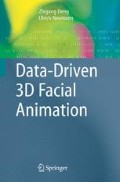Access this chapter
Tax calculation will be finalised at checkout
Purchases are for personal use only
Preview
Unable to display preview. Download preview PDF.
References
Bartels R, Beatty J, Barsky B (1987) An Introduction to Splines for Computer Graphics and Geometric Modeling. Morgan Kaufmann, New York.
Basu S, Oliver N, Pentland A (1998) 3D modeling and tracking of human lip motions. ICCV, pp 337–343.
Berg MD, Kreveld MV, Overmars M, Schwarzkopf O (1997) Computational Geometry. Springer-Verlag, New York.
Blanc C, Schlick C (1995) X-splines: A spline model designed for the end-user. SIGGRAPH Proceedings, pp 377–386.
Bruderlin A, Williams L (1995) Motion signal processing. SIGGRAPH Proceedings, pp 97–104.
Cohen MM, Massaro DW (1993) Modeling coarticulation in synthetic visual speech. In: Models and Techniques in Computer Animation. M. Magnenat-Thalmann and D. Thalmann (eds), Springer-Verlag, Tokyo.
Eck M (1991) Interpolation methods for reconstruction of 3D surfaces from sequences of planar Slices. CAD und Computergraphik, 13(5), February, pp 109–120.
Eck M, DeRose T, Duchamp T (1995) Multiresolution analysis of arbitrary meshes. SIGGRAPH Proceedings, pp 173–182.
Edelsbrunner H, Mucke E (1992) Three-dimensional alpha shapes. Proceedings of the Workshop on Volume Visualization, pp 75–82.
Eisert P, Girod B (1998) Analyzing facial expressions for virtual conferencing. IEEE, Computer Graphics and Applications, 18(5):70–78.
Fidaleo D, Noh J, Kim T, Enciso R, Neumann U (2000) Classification and volume morphing for performance-driven facial animation. Digital and Computational Video (DCV).
Franke R (1982) Scattered data interpolation: Tests of some method. Math. Comp., 38(5): 181–200.
Gleicher M (1998) Retargeting motion to new characters. SIGGRAPH Proceedings, pp 33–42.
Golub GH, Heath M, Wahba G (1979) Generalized cross-validation as a method for choosing a good ridge parameter. Technometrics, 21(2):215–223.
Guenter B, Grimm C, Wood D, Malvar H, Pighin F (1998) Making faces. SIGGRAPH Proceedings, pp 55–66.
Hardy RL (1971) Multiquadric equations of topography and other irregular surfaces. J. Geophys, 76:1905–1915.
Kalra P, Mangili A, Thalmann NM, Thalmann D (1992) Simulation of facial muscle actions based on rational free from deformations. Eurographics, 11(3):59–69.
Kanai T, Suzuki H, Kimura F (2000) Metamorphosis of arbitrary triangular meshes. Computer Graphics and Applications, March, pp 62–75.
Kent JR, Carlson WE, Parent RE (1992) Shape transformation for polyhedral objects. SIGGRAPH Proceedings, pp 47–54.
Lee AWF, Dobkin D, Sweldens W, Schroder P (1999) Multiresolution mesh morphing. SIGGRAPH Proceedings, pp 343–350.
Lee, YC, Terzopoulos D, Waters K (1995) Realistic face modeling for animation. SIGGRAPH Proceedings, pp 55–62.
Lewis JP, Cordner M, Fong N (2000) Pose space deformation: A unified approach to shape interpolation and skeleton-drive deformation. SIGGRAPH Proceedings, pp 165–172.
Maurer T, Von der Malsburg C (1996) Tracking and learning graphs of image sequence of faces. In Proceedings of International Conference on Artificial Neural Networks, Bochum, Germany.
Moody JE (1992) The effective number of parameters: An analysis of generalization and regularization in nonlinear learning systems. Neural Information Processing Systems 4, 847–854, Morgan Kaufmann, San Mateo, CA.
Orr MJL (1998) Optimizing the widths of RBFs. Fifth Brazilian Symposium on Neural Networks, Brazil.
Ostermann J (1998) Animation of synthetic faces in MPEG-4. IEEE Computer Animation, pp 49–55.
Parke FI (1982) Parameterized models for facial animation. IEEE Computer Graphics and Applications, 2(9):61–68.
Penrose R (1955) A generalized inverse for matrices. Proc. Cambridge Philos. Soc., 51: 406–413.
Pighin F, Hecker J, Lischinski D, Szeliski R, Salesin DH (1998) Synthesizing realistic facial expressions from photographs. SIGGRAPH Proceedings, pp 75–84.
Platt S, Badler N (1981) Animating facial expression. Computer Graphics, 15(3):245–252.
Poggio T, Girosi F (1989) A theory of networks for approximation and learning. Technical Report A.I. Memo No. 1140, Artificial Intelligence Lab, MIT, Cambridge, MA, July.
Pratt W (1991) Digital Image Processing, Second Edition. Wiley-Interscience, New York, ISBN 0-471-85766-1.
Shinagawa Y, Kunii TL (1998) Unconstrained automatic image matching using multiresolution critical-point filters. IEEE Transactions on Pattern Analysis and Machine Intelligence, 20(9):994–1010.
Stone MC (1991) Toward, a model of three-dimensional tongue movement. Journal of Phonetics, 19:309–320.
Tikhonov AN, Arsenin VY (1977) Solution of ill-posed problems and the regularization method. Soviet Math. Dokl., 4:1035–1038.
Waters K (1987) A muscle model for animating three-dimensional facial expression. In M.C. Stone (ed), Computer Graphics (SIGGRAPH Proceedings) 21:17–24.
Waters K, Frisbie J (1995) A coordinated muscle model for speech animation. Graphics Interface, pp 163–170.
Williams L (1990) Performance driven facial animation. SIGGRAPH Proceedings, pp 235–242.
Editor information
Editors and Affiliations
Rights and permissions
Copyright information
© 2008 Springer-Verlag London Limited
About this chapter
Cite this chapter
Noh, J., Neumann, U. (2008). Facial Animation by Expression Cloning. In: Deng, Z., Neumann, U. (eds) Data-Driven 3D Facial Animation. Springer, London. https://doi.org/10.1007/978-1-84628-907-1_11
Download citation
DOI: https://doi.org/10.1007/978-1-84628-907-1_11
Publisher Name: Springer, London
Print ISBN: 978-1-84628-906-4
Online ISBN: 978-1-84628-907-1
eBook Packages: Computer ScienceComputer Science (R0)

